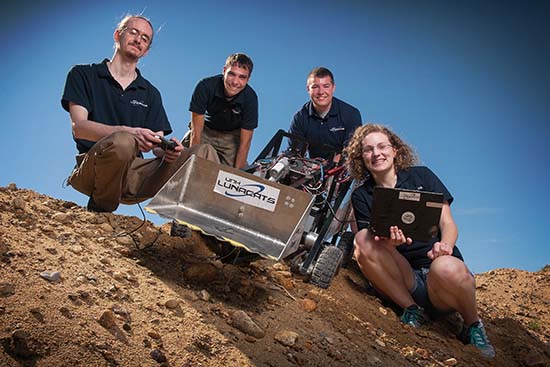 |
 |
| current issue |  | past issues |  | send a letter/news |  | address update |  | advertise |  | about us |  | alumni home |
Campus Currents
|
Moving (Moon) Mountains
LunaCats launch winning effort at Kennedy Space Center. |
Easy to print version |
 Perry Smith/UNH Photographic Services CAT POWER: Members of UNH's LunaCats team pose with their robot on a simulated lunar surface at a NASA competition where they placed 3rd out of 50 teams. Above from left are Jonathan Wilson '12, Anthony Edmonds '14, Jon Shepard '14, and team captain Caleigh MacPherson '12, '14G. Not pictured are James Clifford '13, Drew Garvey '13, Tim Gerade '13, Nick Grauel '13, and Antoine Procyk '13. May-Win Thein, associate professor of mechanical engineering, serves as the team's adviser. |
Can a team of UNH students put their M.O.O.S.E. on the moon? That was the challenge facing the LunaCats in a recent NASA competition to design a space-mining robot. Their Magically Optimized Outer Space Excavator, or M.O.O.S.E, blasted past teams from bigger engineering schools to claim first place in "Efficient Use of Communications Power" and third place among 50 teams in the main event, the mining competition held at the Kennedy Space Center. M.O.O.S.E. scored highly for its simple design, lightweight construction, and efficient use of bandwidth.
This year's competition was the third time the LunaCats set out to dig their way to victory in the "LunArena." Each robot had two 10-minute tries to dig up and move at least 10 kilograms of simulated regolith—the mix of dust, grit, and sharp glassy rock that covers the moon. Although UNH didn't place at all during the team's first year of competition, the students snagged a respectable ninth place on their second try in 2012. And this year, M.O.O.S.E. moved 36.6 and 47.6 kilos in two trials, using only four moving parts and an onboard netbook.
"Last year, we blew a lot of fuses and burned some wires," says two-time team captain Caleigh MacPherson '12, '14G, who worked on the "lunabot" for her senior project and now builds satellites for NASA at UNH's Space Science Center as a master's candidate in mechanical engineering. "The parts that moved the arms up and down were really slow. This year, we fixed all that—it was really zippy. One of the NASA judges said we made it look easy."
MacPherson's interdisciplinary team of mechanical engineering, electrical engineering, and computer science majors included seven undergraduates and an alum. She attributes the team's success to cooperation, experience, and better electrical engineering. "We knew what not to do, what would blow up, and when," MacPherson says. "We did a complete overhaul and made M.O.O.S.E. as simple as possible." Along with tickets to watch a satellite launch at the space center, the team earned $1,000 toward next year's robot. Says MacPherson: "We're aiming for first place."
blog comments powered by Disqus

